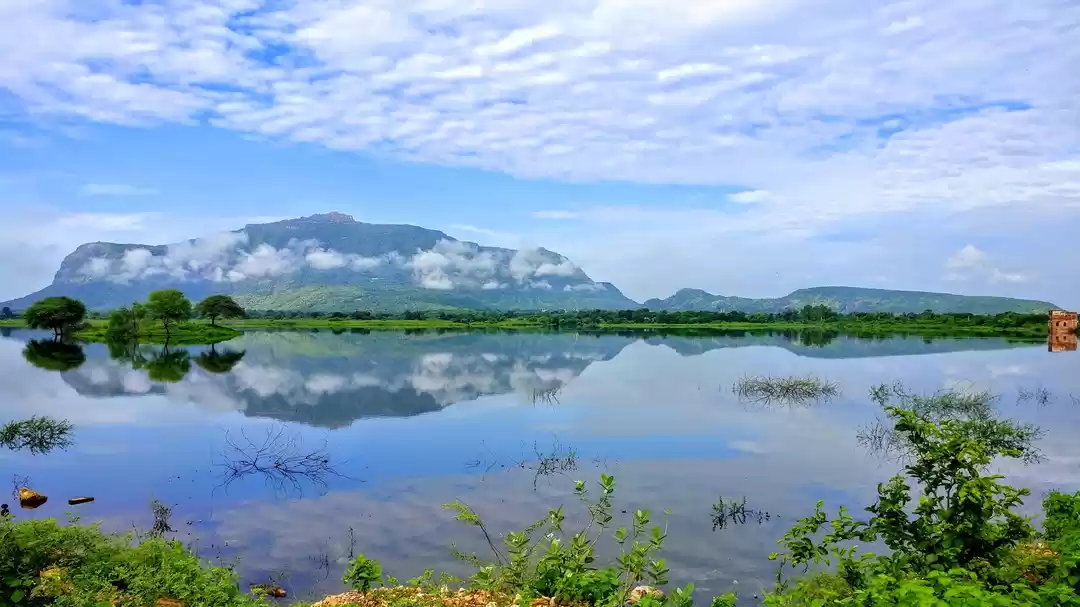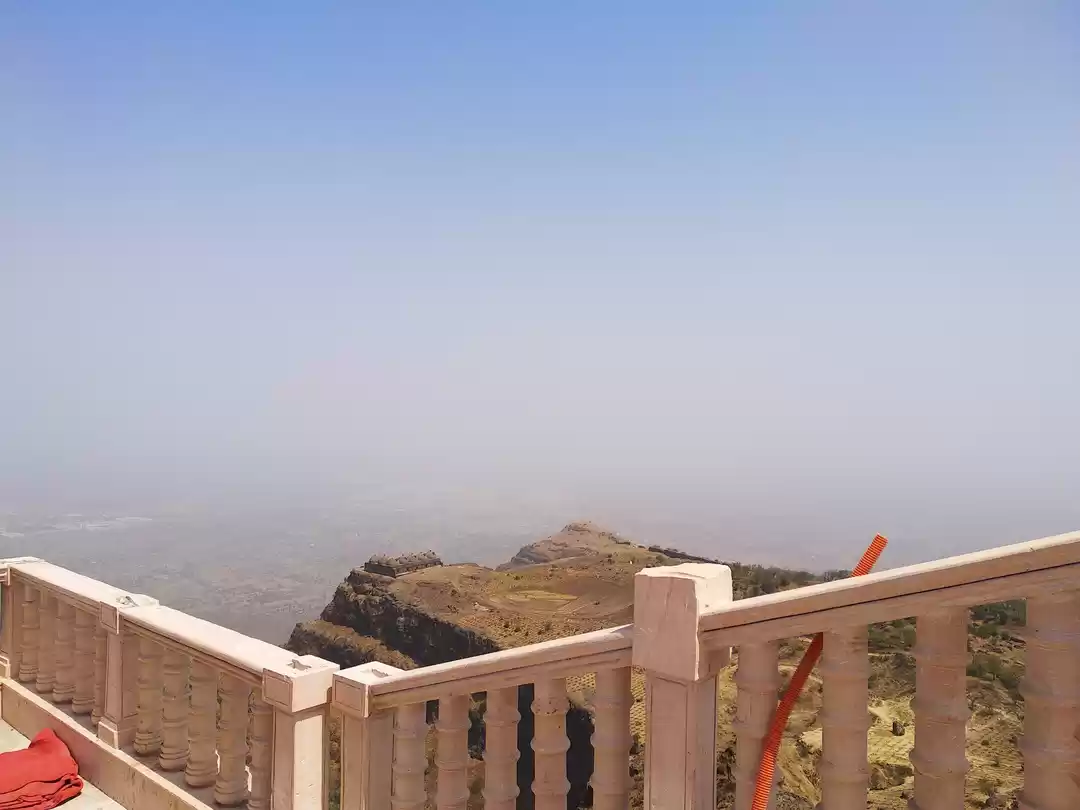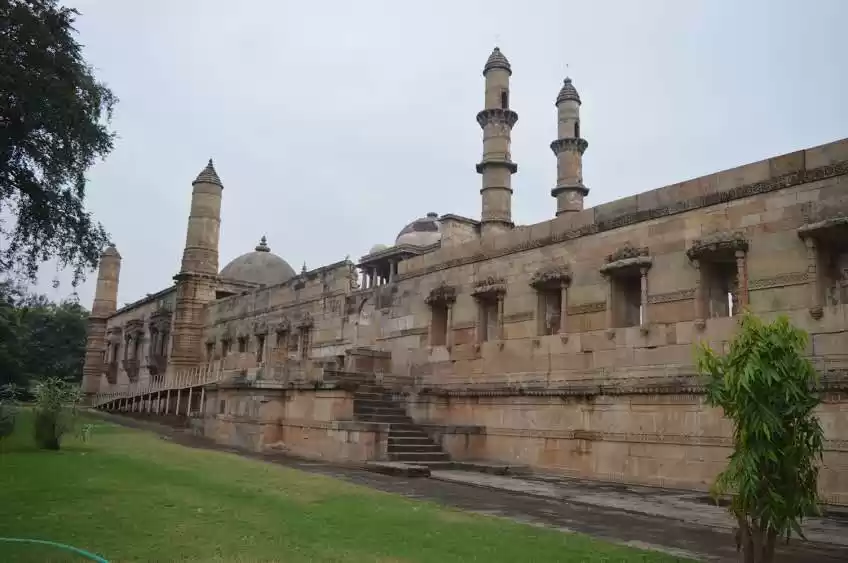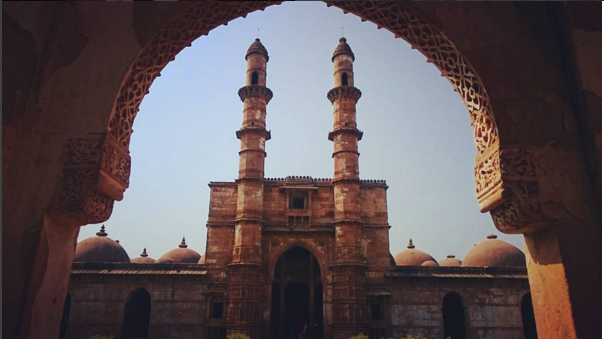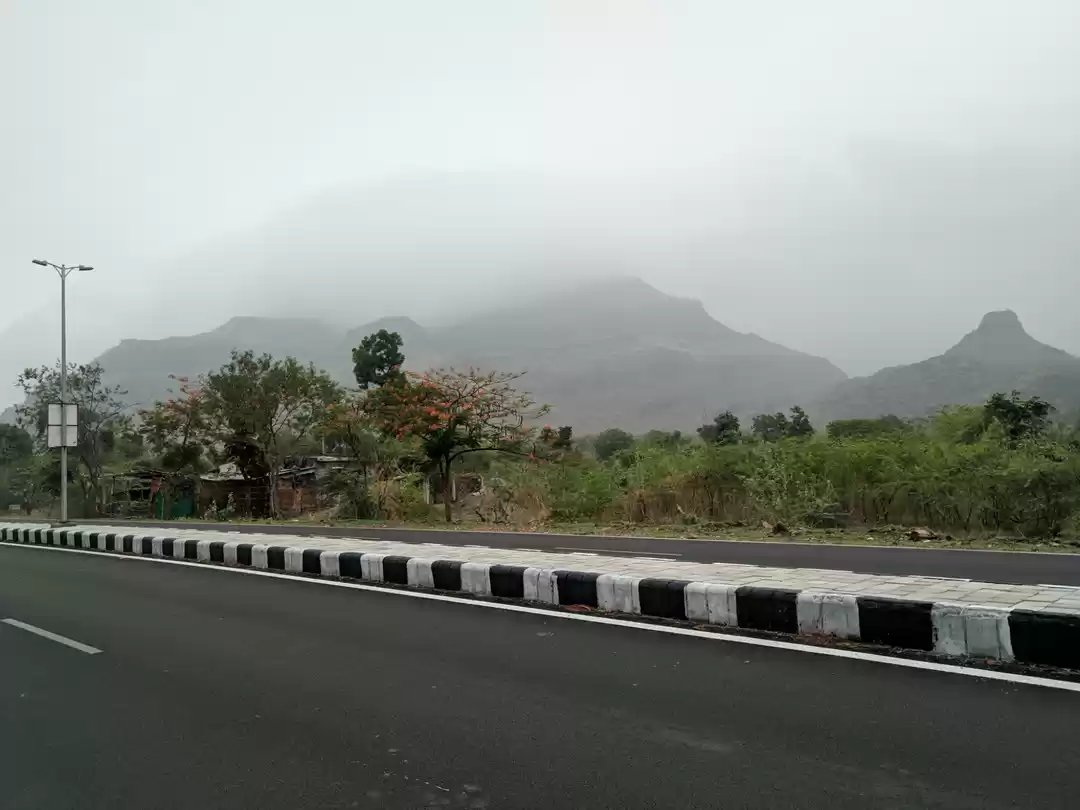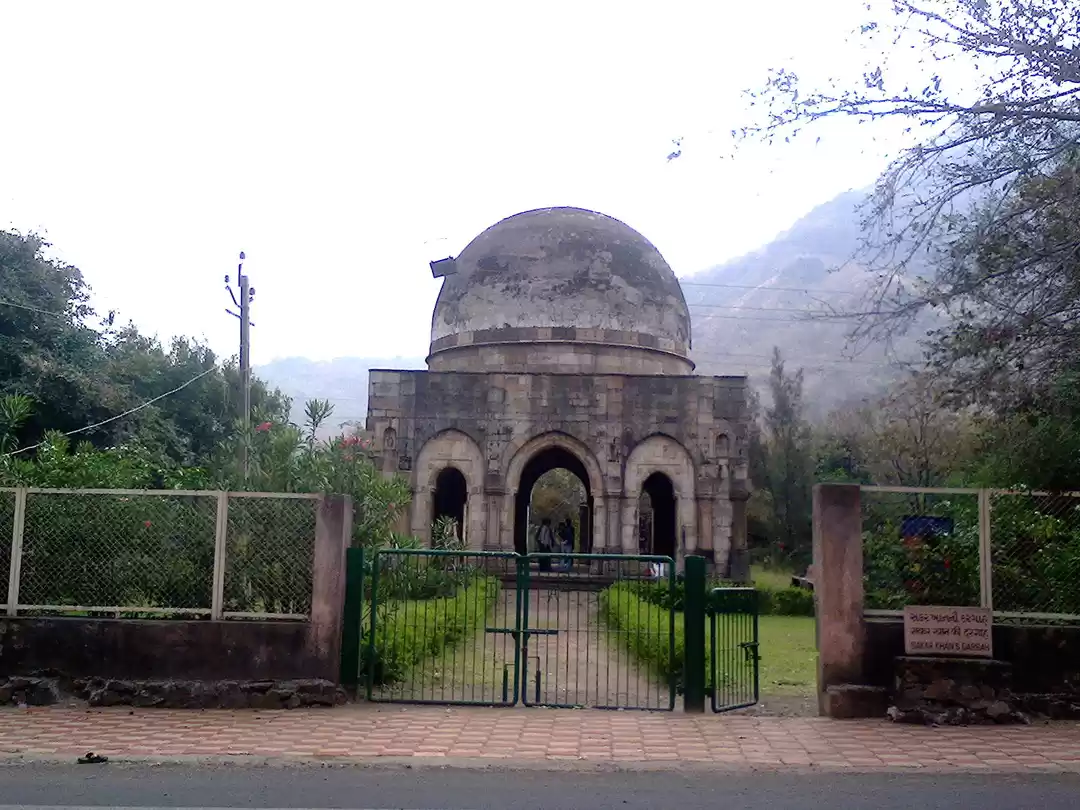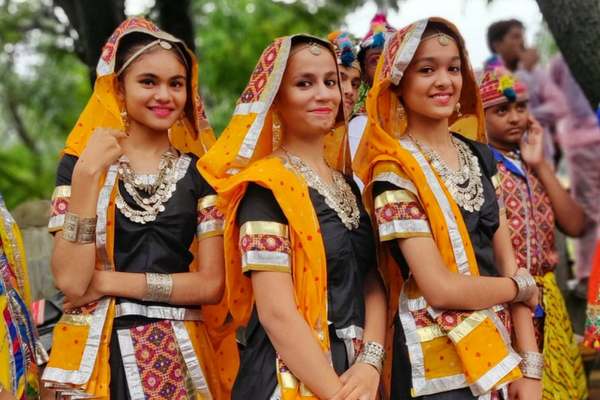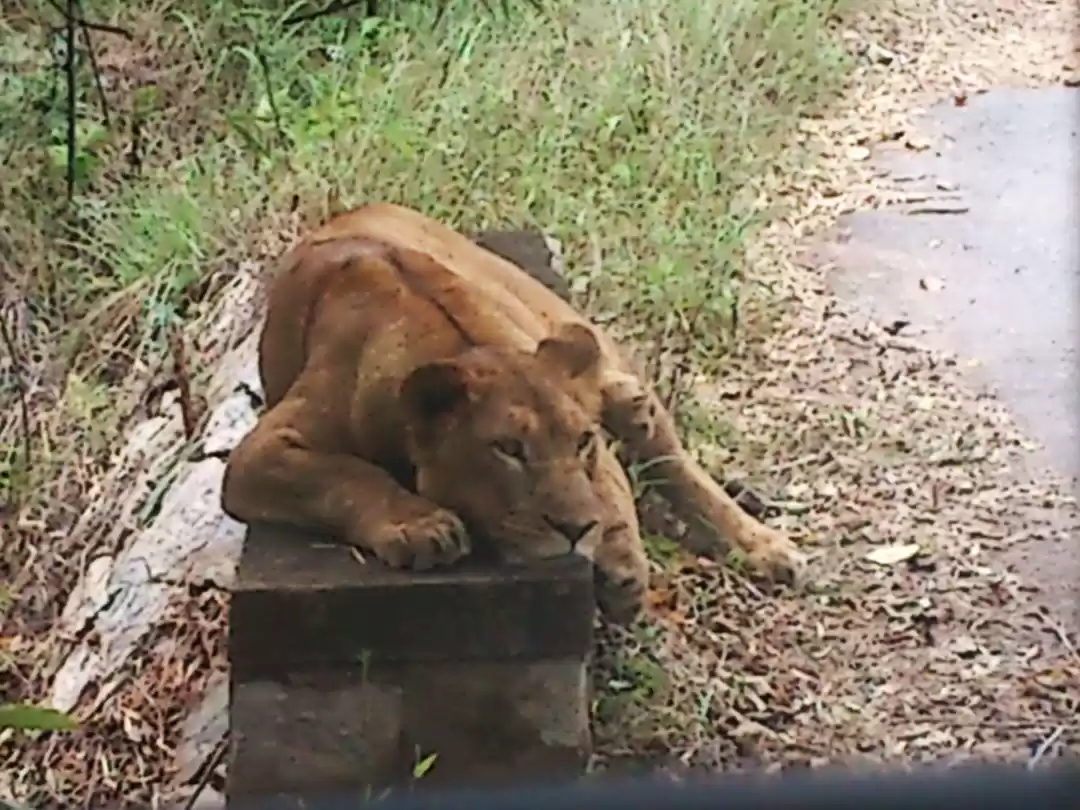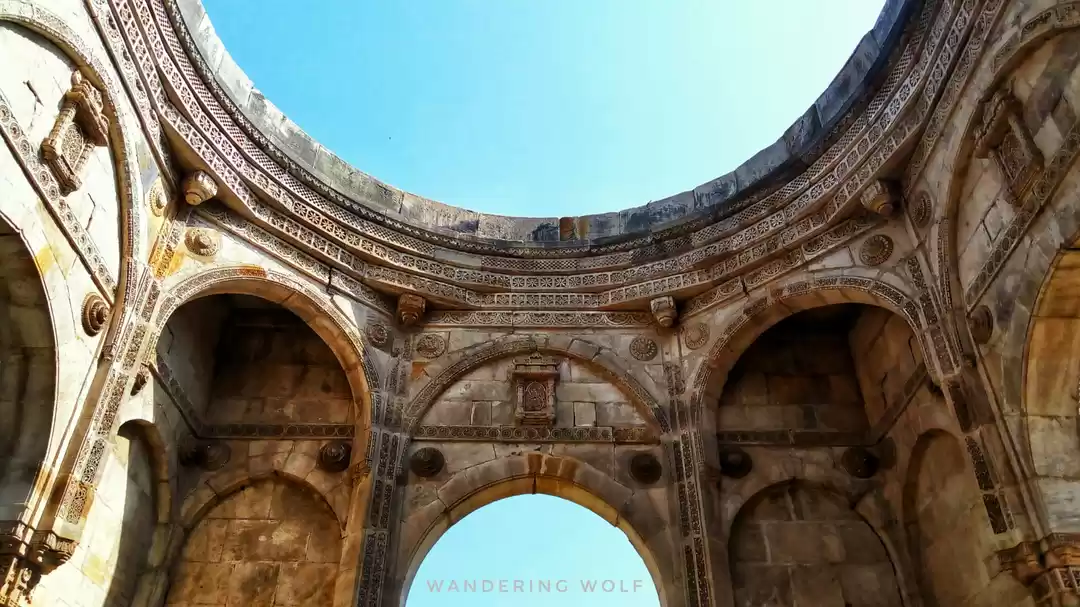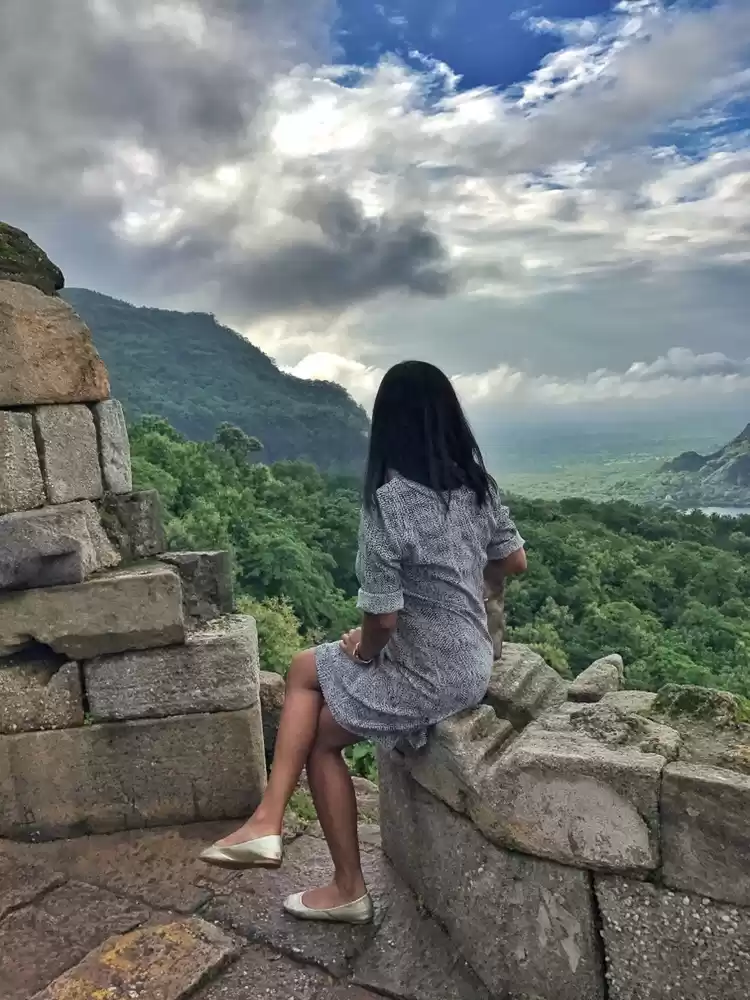
Pavagadh is a solitary hill standing out alone in the plains. Pavagadh hill is made up of volcanic rock, which is what the name Pavagadh suggest (Pavagadh means fire-hill). Pavagadh was once a fortified, self-sustainable town on top of the hill but now its known mostly for the Mahakali temple, a shakti peeth, which draws thousands of pilgrims every day.
Most of the people visit Pavagadh for religious purpose only but you can also visit Pavagadh for watching historical remains, ancient military structure, ancient water management skills or just for adventure. Whatever may be the purpose of your visit, but you will definitely love its natural beauty and spectacular views from the top of the hill.

Aerial view of the cliffs at Pavagadh
UNESCO World Heritage Site
Champaner-Pavagadh, a UNESCO World Heritage Site in Gujarat, is an interesting and unusual case study in how religion, culture, terrain, and climate interact in creating water systems that sustained large communities for 800 years between the eighth and sixteenth centuries.
The earliest settlement occurred on the hill during the Rajput regime around 9 th century and since then several consecutive settlements have come up on different plateau. Each settlement had its own self-sufficient water system making it a unique water intelligent city.
Water is central to Hindu worship rituals and at Pavagadh Hill, embodiment of the goddess Kalika, is symbolic of her nurturing aspects. Pavagadh has only one rivulet, vishwamitri, which dries up in summer. However the "water intelligent settlement" at Pavagadh harvested the rainwater and run off on the Hills slopes were converted into an elaborate system of macro and micro catchments for filling small and large tanks on the hills which ensure the availably of water throughout the year for spiritual, aesthetic and utilitarian purpose. Other than the talao's (pond) which are fed by diverting the flow of run-off water, there are few stone cistern in perfect geometry made by the Rajput kings for storing rainwater. Few of them are still in good condition near Navlakhi Kothar and sat manzil area. With so many small and big tanks at every plateau, Pavagadh hills is nicknamed as the "hill of hundred pools".
Champaner- Pavagadh are same?
Though both places are next to each other, both are different. Champaner- Pavagadh archaeological park roughly consists of two parts viz; Pavagadh hill - which has ruins of fort of Hindu Raval kings and Champner town - the earlier capital of Gujarat sultanat constructed by Mahmud Begada; the Muslim ruler of Gujarat. While Pavagadh mainly consists of Hindu and Jain temples, Champaner consists of lslamic buildings like mosques and tombs. Base of Pavagadh mountain (Machi) is approx. 4km uphill from Champaner town.
History of Pavagadh
It is said that the Rajput king Vanraj Chavda established Champaner at the foot of Pavagadh in fond memory of his wise minister Champa. Adjecent Pavagadh is a geographic succession of five plateaus from top to bottom named viz; Kalika Mata, Mauliya, Bhadrakali, Machi, and Atak are separated by steep cliffs make it a perfect strategic location. The earlier Solanki kings (10th - 12th Century) used this geographic location to their advantage and built a fort on it. In 1300 AD they were succeeded by the Kichchi Chauhan Rajputs who ruled the hills up to 1484 and further improved the fortification. The result was the most ambitious of the constructions here with multiple rings of fortifications - which includes an ingenious network of gateways, watchtowers, garrisons and barracks. When Champaner town below the hill was defeated by Sultan Mahmud Begada in 1482 the king Jai Singh, popularly known as Patai Rawal, has taken refuge in the Pavagadh fort. It took another 20-month siege by Sultan Mahmud Begada to capture the fort.
Inside the fort "Patai Raval No Mahal" was destroyed into ruins by Sultan Begada. Though he destroyed the "Patai Raval No Mahal", he utilise the Fort for the city defense till Champaner was defeated by Mughal emperor Humayun who loot and destroyed the city. Later on, Champaner - Pavagadh was abandoned. Most of the fort is also in ruins but whatever is remaining, tells their glorious past. You can walk along the labyrinthine fort walls from Khapra Zaveri to the Sat Kaman which is the end of Sadan Shah gate. It is located on the edge of a cliff on the south from where military personnel could view the entire town of Champaner below.
How to get there
The journey to the Summit of the Pavagadh Hill Temple involve 3 legs if you are coming by bus and want to reach there by the fastest route. If you have your own vehicle or rental car then you can go up to Pavagadh machi and half of your climbing is covered.
Most of the pilgrims prefer to walk up to the temple. In the latest development the road from Champaner bus stand to Pavagadh machi is widened into 4 lanes and there is a steel barrier with footpath next to the road. This footpath is developed for the pilgrims to go by walk with many resting shelters on the way, but nobody is using this Footpath as people prefer to track through the jungles.
At the base of the Pavagadh mountain, there is parking facility for vehicles for those who don't want to drive on the hilly terrain with hairpin bends and other tour operators. From here you have the option to take Gujarat state transport buses which are running very frequently between Champaner bus stop and Pavagadh machi or you can take shared taxi if you don't want to hike all the way to machi.
If you are coming by your own vehicle there is a paid parking lot at Pavagadh Machi where you can park your vehicle safely. From here, you have the option to join the pilgrims and reach the mountain top by climbing steps or take a ropeway and reach the top which takes approx. 6 minutes one way. Needless to say, we chose the second option. A roundtrip ropeway ticket costs Rs 71 for person less than 110 cm and Rs. 142 for anyone more than 110 cm (in Jan 2020). Skip the line tickets are also available at a premium. Ropeways operate from 6 AM to 6 PM.

Pavagadh ropeway at Machi
After reaching the top by the rope way, the last leg of the journey is still remaining. The temple is still 500 meters away from here. At this point you will be joined by the hikers and the pilgrims. This path is common for all and you will find it full of shops on both sides, selling prasad, pooja items, food, souvenir, devotional CD's and plenty of photo studios. From one of these shops we bought the Pooja thali to be offered to the Godess.



lakulisa Temple, Image © : Lokeshd [https://creativecommons.org]
Just outside the rope way station there is Dudhiya talav where you can see ruins of a very beautifully carved Lakulish Temple. On the way to the Kalika mata temple, we crossed Suparshwanath digamber jain Temple along with another Jain temple in ruins around the Teliya Talav.

We reach there on a clear and sunny day, but the walkway was still comfortable. All the stops from the rope way up to the temple premises is shaded by the shop owners and the Temple authorities. A new and wider staircase was under construction for reaching the temple. After darshan we came down and walked around the Teliya talav. There are lot of construction and beautification works in progress around the area.

Navlakha Kothar, Image © : Itsmalay [https://creativecommons.org]
Other than the Kalika Mata Shakti peeth there are many more things to explore at Pavagadh. For exploring those sites, I advise you to leave the rope way at least while going down. By walking down through the stairs, you can see the walls and gates on the way which would be missed if you use the ropeway again for going down.
There is a walking trail up to the Navlakhi kothar. If you can not find the trail or uncomfortable to use this way, then go towards the rope way station. After the ropeway station there are many jain temples which are worth visiting. From there you can go up to the Navlakhi kothar. Try to make a full circle from temple to Navlakhi kothar and then to the rope way to see the historical remains of the 500 years old kingdom. Navlakhi kothar is on the edge of the cliff the views from there are mind blowing.
Things to do and explore at Pavagadh
For most people the biggest attraction at Pavagadh is to visit Kalika Mata temple, but other than the shakti peeth temple there are many small Hindu and Jain temples in ruins, Jain temple complex, granary, ruins of fort, fort wall, many talav's and abandoned water tanks which were used by the residents of Pavagadh some 800 years ago.
Kalika Mata Temple
It is located on the summit of Pavagadh hill and the main reason for almost all the people coming to Pavagadh for paying their respects and gratitude. It is one of the 51 Shakti Peeth where it is believed that Devi Sati's toe fell here, and the temple was constructed. Thousand of pilgrims visit the temple everyday and on few special occasion and festivals the number of devotees exceed hundred thousand.

Jain Temple, Pavagadh
Jain Temples of Pavagadh
Pavagadh, other than Hindus, is also a pilgrimage place for the Jains of Digamber sect. Suparshwanath Digamber Temple can be seen near Teliya talav while Parsavnath Temple is located next to Dudhiya Talav away from ropeway station with few other small temples. There is another Jain temple in between next to the walking path. Apart from these big and closely located temples, there are Jain temples near Makai Kothar and at the base of Pavagadh.
Gates at Pavagadh

Atak Gate, Image © : Sychonet [https://creativecommons.org]
There are total 8 gates at Pavagadh. The first gate is Atak Gate while ascending Pavagadh Hill. lt is a double storied structure with arrangements for catapults to surprise the enemy with an attack.

Gate No 4, Pavagadh, Image © : Ashok Gajjar [https://creativecommons.org]
Gate no 2- Budhiya Gate, Gate no 3- Moti Gate or Sadan Shah Gate, Gate No. 4 with big bastion with cells in the interior, Gate no 5- Gulan Bulan Gate near the Machi lie in close vicinity of each other and can easily been seen in Pavagadh.
Gate No. 6 Buland Darwaza is near Makai Kothar. From hear you can also go to the ruins of Palace of Patai Rawal.
Sat Manzil
Sat manzil is a stepped bastion which is a seven storied structure built into the hillside. This place is accessible from the main road just before reaching machi with proper pathway. It offers a beautiful view of the valley from its viewing gallery. Nearby sat manzil there are three large water cisterns Ganga, Yamuna, and Saraswati sit on the plateaus. During rainy season if you walk outside the fort walls towards the forest you will be greeted by Khuneshwar Waterfall.
Mint or Tankshala
The mint is above Gate no 4. Here gold, silver, and copper coins were minted by Sultan Begada and his successors. This was one of the only four mints of Gujarat sultanat during that time. When Mughal emperor Humayun conquered Champaner in 1535, he minted coins at this mint to celebrate his victory over the Sultan of Gujarat.
Khapra Zaveri no Mahal
Khapra Zaveri no Mahal has no foundation and was built directly on the rocks over the ravine. These are rooms made of stone projecting over the Valley and used as a military outpost overlooking and controlling the steep Vishwamitri vally. Its slightly away from the main route with a barricaded access path of steep stone steps. This place is not visited by most of the tourist, but you can find many locals visiting this place in monsoon.
Sat Kaman

Sat Kaman with Fort wall
Sat Kaman is one of the most photogenic and popular structures in Pavagadh. You can find the picture of sat Kaman in almost all pavagadh tourism advertisement. As the name suggest, there are seven arches (Sat Kaman) of the old fort on the hill but now only 6 arches remaining. This fort bastion was used to keep an eye of enemy activities around Champaner town and was built of local yellow sandstone. This place is easily accessible from the main road. When we visited the place was closed for restoration.
Things to note
* Everything on the hilltop is supplied through donkeys and mules using the same path as used by pilgrims. these donkeys make the path dirty and still we don't have any rule making owner responsible for cleaning. So, mind your steps while walking the pilgrimage path.
* Toilet facilities are still scared. New toilets are constructed near the Teliya Talav and Machi but still it's better to use the Ropeway toilet.
* Overall cleanliness is improved at all the places in Pavagadh then what it was before. Garbage bin are placed everywhere but still you can find some litter.
* You can find food and beverage store and resturants everywhere from machi up to the base of the temple. In my opinion the most hygienic option is the ropeway cafeteria.
* If you want the service of a guide, many of them are available at Pavagadh. if you wish to hire an english speaking guide then please contact the Pavagadh Hotel at Machi, Pavagadh operated by Gujarat Tourism.


